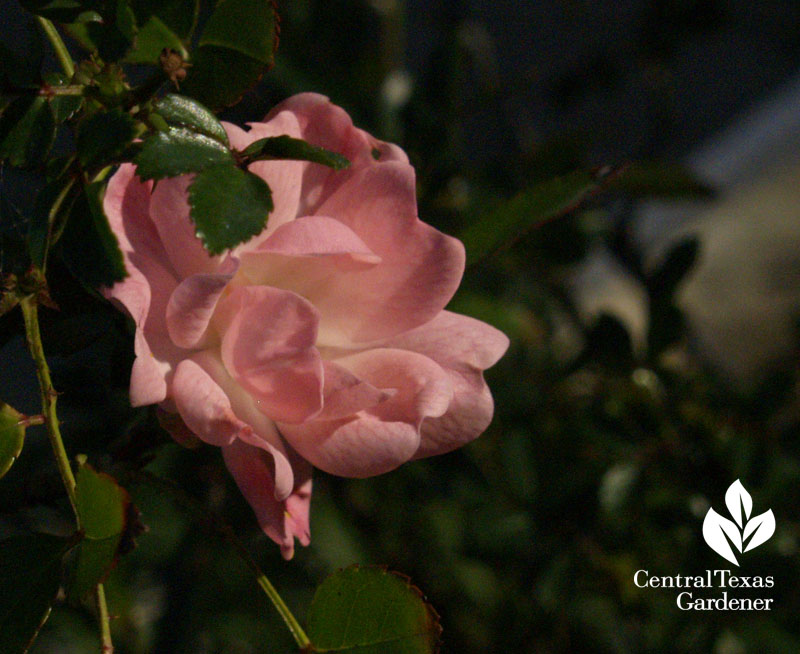April 4, 2013
Minus Lawn Equals Plus
My knee can tell you how much grass I’ve dug up over time! My shovel moans, too, if we count the holes we’ve dug to fill the blanks. Actually, one shovel committed suicide. The pain is worth the gain, like when The Fairy rose—instead of fried grass– romances our hot front curb.

Past or current grass gets only the minimal water I give everybody else. Fertilizer? Not for me. Mainly, I’ve diversified because I want this:

At some point, I decided if I was going to turn on the spigot, it had to be for plants that re-populate wildlife as their food sources diminish. That golden groundsel (Packera obovata) does a fine job in early spring. Texas betony extends the buffet for months to entice hummingbirds that will stick around for Turk’s cap on the horizon.

Gulf penstemon and poppies are booked up with springtime diners.

Even bulbs, like my Spanish bluebells (Hyacinthoides hispanicus), attract the paparazzi.

In the new vegetable bed, native Baby blue eyes came along in my home-made compost. They’re not all about looks: the bees will hang around to pollinate my new tomatoes and squash.

Designer Pam Penick shows you how to capture your own version of reduced or no-lawn magic in her book Lawn Gone!

This week, she joins host Tom Spencer to share a few of her DIY tips, techniques, and lovely alternatives for outdoor living minus grass.

With plant options, practical design ideas, ponds, and HOA wrangles, she makes it easy to go Lawn Gone!

This week’s viewer question comes from Diane Salazar: how to get rid of weeds and make gardens in her new house left vacant for months.

Get Daphne’s answer on first steps for Diane’s soil restoration and the best way to smother weeds with newspaper.
Since food is replacing lawn for many gardeners, Daphne’s Pick of the Week is deliciously productive tatume squash, an heirloom variety less troubled by the evil squash vine borer. CTG thanks Master Gardener and blogger Caroline Homer for her hands-on tips and a picture from her crazy abundant harvest last summer.

On tour, see how Meredith Thomas banished lawn for family food by recycling “pre-owned” materials to build beds, including a hugelkulter/keyhole concept, and artwork. She doesn’t buy fertilizer—you just have to see what she does in her own fabulous words. Dear thanks to composer Freejay MacLoud who shared his music that just so perfectly matches Meredith’s truly organic philosophy.
I’ve got the best arugula ever, thanks to Meredith’s passalong seeds of Rocket (also called Rocquette).

Those little insects on it are flea beetles. That’s fine by me because eventually “someone” ate them. You’ll only get long-term predators if you have seasonal prey. Leafy holes didn’t matter a bit in our salads and bunny dinner treats. I’ll be collecting seeds: to paraphrase Meredith, nature provides our own little seed packets!
And what about those wildflower seed packets? The party doesn’t end in spring, especially for wildlife that relies on us all year long. So, Andrea DeLong-Amaya from the Lady Bird Johnson Wildflower Center shows off a few seeds to scatter now, like native partridge pea (Chamaecrista fasciculata).

Heads up: Get native seeds, perennials (like hard-to-find golden groundsel), shrubs, trees and a lot more at the Wildflower Center’s spring plant sale April 13-14. Member’s day on April 12, but you can join that day to get the first picks! They also have a list online for available plants, so gear up that little red wagon.
Thanks for stopping by! See you next week, Linda
tags:

